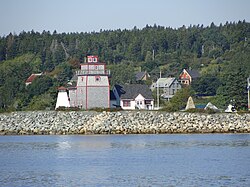LaHave, Nova Scotia
| LaHave, Nova Scotia | |
|---|---|
| Community | |

Fort Point Museum, LaHave, Nova Scotia
|
|
| Location within Nova Scotia | |
| Coordinates: 44°17′37.25″N 64°21′27.22″W / 44.2936806°N 64.3575611°WCoordinates: 44°17′37.25″N 64°21′27.22″W / 44.2936806°N 64.3575611°W | |
| Country | Canada |
| Province | Nova Scotia |
| Municipality | Lunenburg Municipality |
| Settled | 1632 |
| Elevation | 0 m (0 ft) |
| Highest elevation | 119 m (390 ft) |
| Lowest elevation | 0 m (0 ft) |
| Time zone | AST (UTC-4) |
| • Summer (DST) | ADT (UTC-3) |
| Canadian Postal code | B0R 1C0 |
| Area code(s) | 902 |
| Telephone Exchanges | 688 |
| NTS Map | 021A08 |
| GNBC Code | CBFUW |
| Website | www |
LaHave is a Canadian community in Lunenburg County, Nova Scotia. The community is located across the river from Riverport and approximately 15 kilometres from the town of Bridgewater. Once the capital of Acadia, it is located on Highway 331 at the mouth of the 97 km long LaHave River.
La Have was an important centre for the Mi'kmaq people, who traded with Europeans. Messamouet, a well-known sakmow, or Chief, of the Mi'kmaq Nation, is reported to have been from the La Have area.
Samuel de Champlain called there in 1604 on his first trip to Acadia. Henry Hudson made landfall there in 1609 on his voyage on behalf of the Dutch East India company. Despite being shown hospitality by the Mi'kmaq, Hudson's crew staged an unprovoked assault on the Mi'kmaq settlement. As a result, the Mi'kmaq staged a raid on the next Dutch ship to visit in 1611.
LaHave was the capital of Acadia from 1632, when Isaac de Razilly settled on a point of land at the mouth of the LaHave River, until his sudden death in 1636. Razilly established a colony of 300 and built Fort Ste. Marie de Grace. Razilly reported that the fort was capable of standing against all enemy action, and that he had the military supplies necessary to withstand a six-month siege. There was also a chapel, a store and houses for the workmen in the village. Within twelve months of Razilly's arrival, La Have was a thriving trading post, the centre for a small farming community in the area, and a major port of call for the large fishing fleet. At one point there were five hundred transient fishermen in the settlement. Upon de Razilly's death, the new Governor Charles de Menou d'Aulnay moved the Acadians from LaHave to Port Royal, Nova Scotia, which had been given up by the Scottish also in 1632. His wife Jeanne Motin, "daughter of Louis Motin, Sieur de Courcelles, who in addition to owning shares in the Razilly-Condonnier Company, was the controller of salt stores located at one of France's colonies, perhaps in the Caribbean", was of great strategic value in the subsequent struggle with La Tour. Ironically, she became Lady La Tour in 1653 after d'Aulnay's death and La Tour's triumphant return with Letters Patent as governor of Acadia. Nicholas Denys and his brother Simon, who had come over with de Razilly, in 1632, set up a "wood working plant" near present-day Riverport, Nova Scotia and a fishing station at Port Rossignol (now Liverpool, Nova Scotia). They stayed neutral in the war between d'Aulnay (at Port Royal) and La Tour (at Fort La Tour on the Saint John River).
...
Wikipedia

